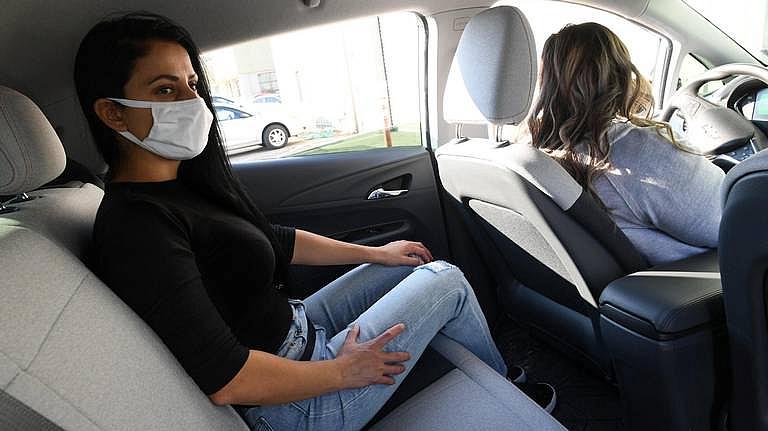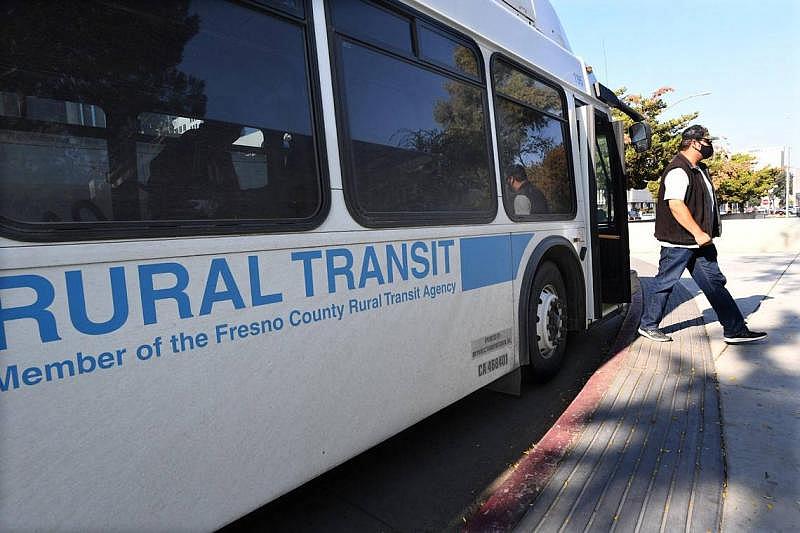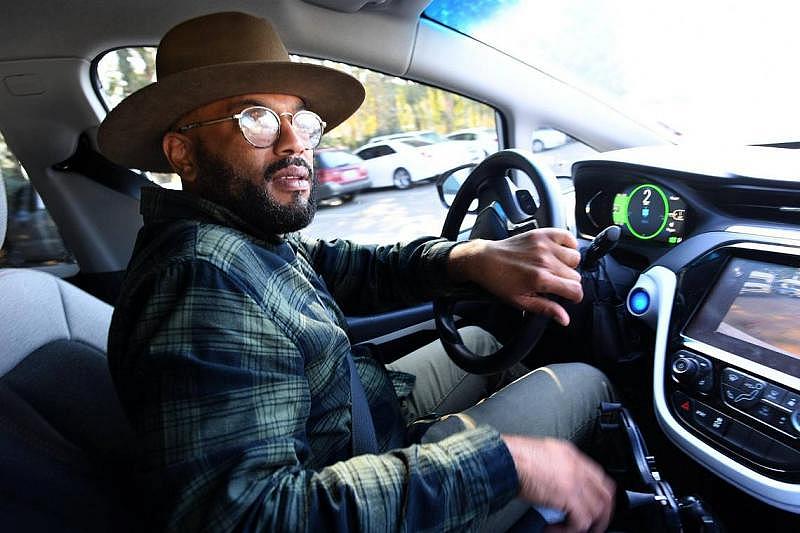‘There’s a big need.’ How a lack of public transit impacts people in rural Fresno County
This story is part of a series produced for the USC Annenberg Center for Health Journalism’s 2021 California Fellowship.
Other work by Danielle Bergstrom includes:
This Week in Fresnoland: What is transportation justice?
Left out and overlooked: How rural Fresno County roads and transit are neglected
What’s Measure C? Why Fresno County could be voting on another sales tax measure
Fresno County’s rural residents face transportation gaps. How electric rideshare programs help
Are Fresno’s car-less residents being left behind? What it means to our community
Fights over budgets, buses & sprawl threaten Fresno County’s Measure C transportation tax

Karina Jimenez Macias lives in Biola and is one of Inspiration Transportation’s frequent riders. This service allows her to work in Fresno and not have to be worried about unreliable transportation.
JOHN WALKER JWALKER@FRESNOBEE.COM
BY DYMPNA UGWU-OJU
Maria del Carmen Valencia has lived in West Park, an unincorporated community just a few miles west of Fresno, for 16 years.
The 45-year-old knows the frustration of having no way to get from her home to anywhere beyond a walking distance.
There are no grocery stores or medical clinics in West Park. Even though her family struggled financially and could have used her earnings, she could not get a job because she had no way of getting there.
“I felt really bad because they would give me work, but I could not get there. How am I going to get there by bus or get back?” Valencia said. “I was mad, frustrated. I wanted to work but couldn’t get there; that’s how it was for many years.”
Karina Jiménez Macias of Biola also understands needing to work, getting a job, but not being able to get there.
“It’s frustrating,” Macias said. “Wanting to do things and not being able to is called frustration.”
Matt Gillian, a Fresno local, has started a nonprofit electric car service for people in rural areas that often cannot afford Uber and don't have access to other modes of transportation. It's called Inspiration Transportation. BY JOHN WALKER
Not having transportation that reliably gets you where you need to be is certainly frustrating, but for hundreds of thousands of residents in rural areas of Fresno County — such as Del Rey, West Park and Mendota — completing daily tasks like grocery shopping or going to a doctor’s office become monumental if transportation is required. For them, not having dependable and affordable transportation dictates their whole lives.
“It makes it so difficult to go to informative meetings, to go to school, to go to the store for what you need — and even more for people with disabilities,” said Ofelia Ochoa, a Mendota resident and member of Mujeres Activas por Mendota (Women Active for Mendota.)
“More than anything the transportation that is needed is local (transportation) because, for example, there are a lot of people in my community that don’t drive or only have one car or don’t even have a car,” Ochoa said.
What is evident from people interviewed as well as a report by the Fresno County Rural Transit Agency is that the people most impacted by transportation inadequacy in the county are bound by factors such as their socio-economic status and a powerlessness to control their lives.
Some of the examples provided by those interviewed for this story show how their lives are shaped each day because of a lack of, or insufficiencies in, public transportation or a late or missed bus around Fresno County, especially in rural and unincorporated areas.
- They miss or are late for doctors’ appointments.
- They can be penalized by doctors’ offices.
- They cannot participate in activities outside of the restricted bus schedules.
- Their children are late or absent from school.
- They end up having to stand around at the bus stop for hours due to unpredictability.
- They have immense difficulties traveling between communities for work or leisure.
- Even when they qualify for medically-necessary transportation, they are constrained by limitations in time and scope.
TRANSIT RIDERS HAVE FEW CHOICES
Nearly 80% of Fresno County’s transit riders are completely reliant on public transportation, without any access to a reliable vehicle, according to the 2018 Regional Transportation Plan. This number is more than double the national average.
They’re also much more likely to work in low-wage jobs, attend school, or both.
Commute times for those who take the bus are at least 15 minutes higher than Fresno County drivers, according to 2019 American Community Survey data.
RURAL TRIPS CAN TAKE SEVERAL HOURS
If you live in Coalinga, for instance, and need to see your doctor at or around Community Regional Medical Center in downtown Fresno on a weekday, how much commute time should you plan for?
If you have a car, the ride from Coalinga to the community hospital (62.5 to 65.7 miles, depending on route) takes approximately 70 to 74 minutes, costing about $8 for gasoline, according to mapquest.com.
For users of the InterCity Transit between Coalinga and Fresno, however, the trip is life altering.
According to schedules available at the website of the Fresno County Rural Transit Agency, you have to be at the bus stop at the Coalinga Courthouse on 160 Elm in enough time to catch the once-a-day service that leaves at 8 a.m.
The bus makes 11 stops to pick and drop off passengers in Lanare, Riverdale, Elkhorn, Caruthers, Mountain View, Manning, Easton and two more stops in Fresno before getting you to the hospital at 2823 Fresno St. at 10:55 a.m. — about three hours if the bus is on time, and traffic en route is not too heavy. A one-way fare runs $5.50 and $3.75 for senior citizens and people with disabilities.
If your doctor’s office is not in the immediate vicinity of the bus’ three stops in Fresno, you must make connections with FAX buses to get to your appointment. Afterwards, the once-a-day transit service to Coalinga leaves the Community Regional Medical Center area at 3:12 p.m., getting you to the Coalinga Courthouse at 5:45 p.m.
Many users of the transit service have asked why the bus makes so many stops and takes so long.
“These are fixed routes in rural communities that have distance as a challenge,” said Moses Stites, director of Fresno County Rural Transit Agency. “Two hours is not uncommon. What we’re trying to do is meet that challenge by providing service and connecting service for the majority of the passengers.”
A passenger gets off one of the Fresno County Rural Transit Agency buses, this one from Huron/Coalinga, at the county courthouse, Oct. 28, 2021. JOHN WALKER JWALKER@FRESNOBEE.COM
Stites explained that FCRTA’s main goal is to provide service for as many people as possible. So when residents complain that the rides are lengthy and that buses make so many stops, he asks them, “‘Which of those unincorporated communities do you want FCRTA (Fresno County Regional Transit Agency) to eliminate?’ and I don’t get an answer.”
For some employers, the transportation challenges facing rural communities have spurred them to take on the burden. Bitwise Industries — which has over 5,000 people enrolled in classes at their Fresno campus, with another 100 apprentices and 250 employees — launched a van service to make sure they get everyone to campus.
“For the people we serve, when we can get transportation to them, it’s a game changer — it opens up possibilities for their lives,” explained Thilani Grubel, vice president for Bitwise Industries in Fresno.
‘THERE’S A BIG NEED’
What does a resident in a community with no regular transportation service do?
“It’s a battle,” said Offelia Ochoa, a Mendota resident who is raising a child with a disability.
Her son often has numerous medical-related appointments in Fresno and Clovis, and after many failed attempts and missed appointments, she learned that she must advocate for herself and other parents like herself to get the resources her son needs.
Now she attends the Mendota City Council meetings “to stress the needs of the community, but a lot of the time, there isn’t a lot of, how do I say it, response. And I need them to listen somehow. We need to continue somehow insisting so they listen.”
“There are kids with special needs that have therapy appointments in Fresno, Clovis, other areas, and they have lost appointments because there isn’t transportation and that’s not good,” Ochoa said. “I’ve spoken with them (government leaders), they know the needs; there’s a big need ... they know.”
Mendota is one of the incorporated towns with direct transportation service to Fresno. According to information on their website, FCRTA’s Westside transit provides two trips to Fresno each day. Originating in Firebaugh at 7 a.m, the bus makes three stops in Mendota between 7:20 and 7:26 and gets to the Fresno Courthouse park at 8:11 a.m. — 51 minutes later.
Ochoa’s son is also eligible for another transport service provided by Medi-Cal.
“The transport (Medi-Cal) sends doesn’t just pick up one person, no, they have to take three or four or however many,” she said of transport service, a service Ochoa says is not convenient for an ill or physically challenged passenger. “If I have my appointment at 10 in the morning, they have to pick me before 6 a.m. to pick up everyone else and get there on time.”
“It is great that they help us and it serves us a lot, but there are times where people want to get back to their house quickly, especially if they took strong medicine and they want to get back to their house and rest. The elderly who go on dialysis need to go home and rest because they are on dialysis for two or three hours sitting and then the transportation has to go elsewhere to drop people off first, that’s frustrating, that isn’t good.”

Maria del Carmen Valencia said having no transportation service in West Park was very limiting.
“When my kids were little, and there was an emergency and we needed to go to the doctor or go to any appointment, there were no services,” she said. “We struggled a lot to even get food, milk, everything.”
Valencia said she tried to rideshare. ”If a neighbor was going to the store I’d ask them ‘tell me when you’re going, and I’ll go with you.’ If there was time, I would wait for my husband to (be off work) so he could take me, so I would make all my appointments on his rest days, but it was really stressful for him because it was his rest days, and I’d have him going up and down, going here and there.”
Occasionally, she took a taxi, “but it’s very expensive; $35 to just go to Fresno, one way.”
LOW RIDERSHIP EXACERBATES SERVICE CHALLENGES
The decision to provide transit service to rural communities depends largely on the money — “how much it would cost to actually run the transit,” said Victoria Santillan, a community worker with the California Rural Legal Assistance, who has worked with the communities of Del Rey, West Park and Mendota.
“Basically, when the Fresno County Rural Transit Agency decides to move forward and provide a community with transportation, part of the deal was that they would have to meet a certain farebox ratio,” Santillan said.
In California, transit agencies are required to use passenger fares to pay a minimum share of the total cost of the route, in order to be eligible for state transit funding. That percentage — 10% for rural transit agencies like Fresno County Rural Transit, and 20% for urban transit agencies like Fresno Area Express — is called farebox recovery.
“Ten percent farebox recovery is a barrier to implementing and maintaining some of these programs, because we have to have certain ridership characteristics,” Stites said.
“Oftentimes, we overlook some of these indicators, because we have to maintain certain requirements for us to maintain our funding; it’s not just that we don’t want to provide service. There are certain thresholds that have to be met in order for these services to be executed, and to be sustained.”
FCRTA uses their annual allocation of Measure C transit funds to keep fares free for veterans, seniors, and disabled passengers seeking demand-response trips between rural communities and Fresno/Clovis — necessitating more funding to come from fares on fixed-transit.
For rural communities, getting high enough ridership to justify the cost of the route can be nearly impossible. It could be creating a self-perpetuating cycle: is it hard to attract riders because the service is inconvenient, thus justifying even more service cuts?
FIXED TRANSIT SERVICE DIFFICULT TO ACHIEVE IN WEST PARK
West Park residents tell stories of the numerous failed attempts to start a transportation service between the community and Fresno. Each time, the attempt collapsed because of low ridership or patronage, which is interpreted by FCRTA as low interest on the part of the community which then led to cancellation.
Santillan told of a transit service that started in October 2017 but was canceled in 2018 due to low ridership. “They expected more ridership in order to meet that farebox, and during that time, there may have been one person who was using the transit daily, and then throughout the week, it varied from two to three people.”
Another attempt was started soon after but it failed in six months, leaving the community with no transportation.
“Moses (Stites) tried everything,” Santillan said. “They gave out cookies and fliers to promote the service.” Three separate attempts later, nothing worked.
But why would the West Park community be hesitant to use a service that many residents say is very much needed? The answer depends on whom you ask.
“I’m not sure what happened, maybe not enough people went on it, I don’t know,” Maria del Carmen Valencia said. “It’s just that it had weird hours; when you needed the service, it wasn’t available, and when you left, it was like, how are you going to get back?”
Santillan said some residents may have had difficulty with the technology of reading bus schedules, “some residents who are only Spanish speaking don’t know how to navigate the system.”
‘MICRO TRANSIT’ HAILED AS FUTURE FOR RURAL RESIDENTS
The quest to provide service to all parts of Fresno County, including communities that may not be able to access those routes, has led FCRTA to new ways of transporting residents. The agency has two micro transit demonstration services for the communities of West Park and Biola since fixed route and demand response services did not work previously in those two locations previously.
Starting in October 2020, the demonstration rideshare program utilizes electric vehicles.
One such innovation is Inspiration Transportation — a private nonprofit — which, with some support from the Measure C sales tax, is offering micro transit service to residents in West Park and Biola and exploring how to expand the service to other communities. Rides cost $5 for a round trip.
Measure C dollars — because they don’t have requirements around ridership or farebox recovery — are the most flexible for FCRTA to meet rural transit demand. FCRTA uses their annual allocation of Measure C transit funds to subsidize fares for fixed-transit routes and to ensure fares are free for veterans, seniors, and disabled people seeking demand-response trips to and from Fresno.
Matt Gillian behind the wheel of an electric Chevrolet Volt, Oct. 28, 2021, one of the cars used in his nonprofit Inspiration Transportation, a service for people in rural areas that often cannot afford Uber and don’t have access to other modes of transportation. JOHN WALKER JWALKER@FRESNOBEE.COM
Inspiration Transportation provides transportation for specific appointments such as to social services and medical appointments, and to employment as well as education, but not for recreation.
“I had somebody call, a woman called and left a message for us, wanting to know if we could transport her three adolescent kids that are 13, 14, and 15 to school for a week and a half while she was on vacation in Hawaii,” said Matt Gillian. “We had to let her know that unfortunately, that’s not what our services are for.”
Gillian, who grew up in Fresno, was living in the Bay Area and pursuing a music career. Upon moving back to Fresno, he wanted to make a difference.
“I want to be able to create something here in my hometown, that my son can look back on and be like, ‘man, Dad had an effect on our town here’,” Gillian said.
“It’s how I affect multiple families’ lives and multiple families can be lifted up, because if multiple families are lifted up in my own town, in my area, I’m going to be lifted up. It’s going to be better for me and my family.”
Danielle Bergstrom, Cassandra Garibay and Monica Vaughan contributed to this story.
This story is part of a series produced as a project for the USC Annenberg Center for Health Journalism’s 2021 California Fellowship.
[This article was originally published by The Fresno Bee.]
Did you like this story? Your support means a lot! Your tax-deductible donation will advance our mission of supporting journalism as a catalyst for change.

